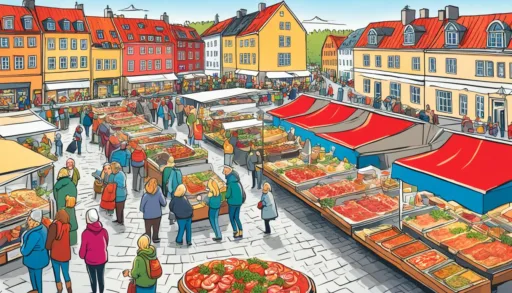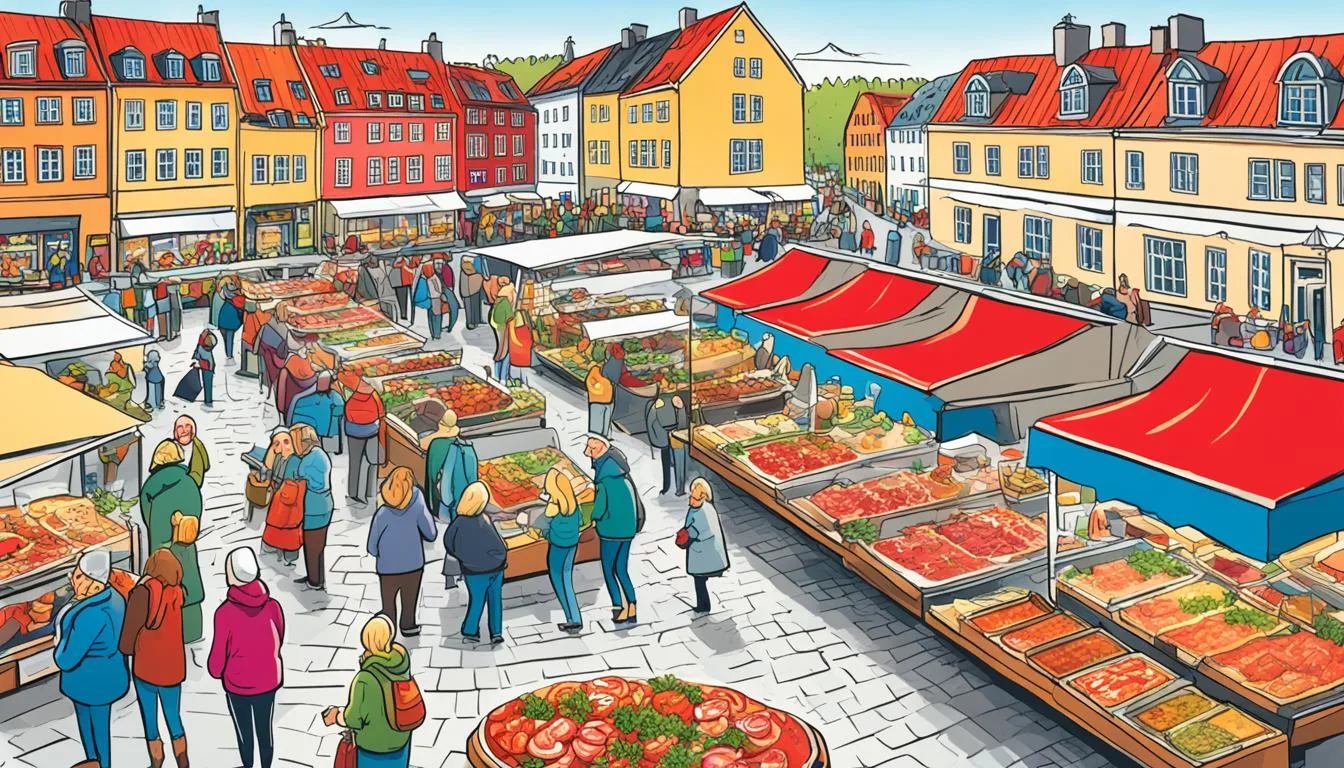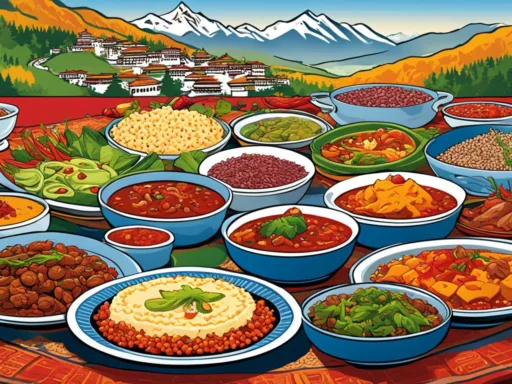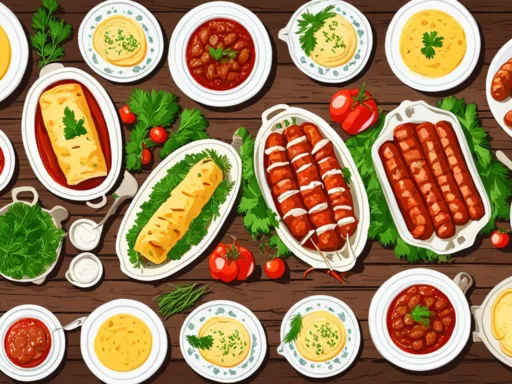Embarking on a Swedish Culinary Tour offers more than just a smorgasbord of flavors; it’s an odyssey through time-honored traditions and an invitation to indulge in a rich food and wine experience. Drawn from the hearty soils of Scandinavia, the ingredients that define Scandinavian cuisine exploration have stories to tell and secrets to share. Join us as we unravel the tapestries of taste that make a gastronomic journey in Sweden an unforgettable quest for epicureans and adventurers alike. Whether you’re craving comfort food or seeking a sophisticated culinary travel package, the essence of authentic Swedish fare awaits your discovery and delight.
Key Takeaways
- Discover the historical origins of Swedish food and its connection to the Vikings.
- Experience a unique blend of comfort and innovation with local Swedish dishes.
- Explore the seasonal impact on traditional and modern Scandinavian cuisine.
- Learn how a culinary travel package can deepen your appreciation for Swedish gastronomy.
- Gain insight into the sustainable practices shaping the future of Sweden’s culinary scene.
The Historical Roots of Sweden’s Gastronomy
Delving into the heart of Scandinavian cuisine exploration, we find that Sweden’s flavors are deeply rooted in history. The continuity of ancient Swedish culinary methods within modern practices invites both locals and travelers to a unique table, where the past and present deliciously intertwine.
Ancient Techniques in Modern Swedish Cuisine
Sweden’s gastronomic narrative is a tale of survival and innovation. Techniques such as pickling and fermenting are more than just culinary trends; they are a legacy from the Viking era, preserved and perfected over centuries. These methods not only allowed ancient Swedes to thrive in harsh climates but also provided the foundation for many Swedish dishes celebrated today.
The Seasonal Impact on Swedish Culinary Traditions
Rhythms of the earth resonate strongly in Sweden, with each season heralding a new chapter in its culinary saga. Seasonal shifts significantly shape the array of seasonal Swedish dishes, often dictating the ingredients and techniques used in kitchens across the country.
- Spring brings foraged greens and the first harvests of rhubarb and fresh herbs.
- Summer offers a bounty of berries and wild mushrooms, inspiring both sweet and savory creations.
- Autumn calls for heartier meals with root vegetables and game.
- Winter centers on preserving and fermenting to sustain through the cold months.
The Influence of Climate on Swedish Agriculture and Diet
From the frigid north to the temperate south, Sweden’s elongated form ensures a variety of climates, each leaving its imprint on the nation’s agriculture. The cultivation and consumption of local crops like onions, turnips, and the vital potato were informed by these conditions. The emphasis on traditional Swedish agriculture is a testament to the resilient spirit of Swedish people, nurturing a diet grounded in locality and sustainability.
| Ingredient | Historical Significance | Contemporary Use |
|---|---|---|
| Potatoes | Became a staple in 18th-century Sweden | Base for dishes like Pyttipanna |
| Rye | Used in traditional crisp bread (Knäckebröd) | Remains a beloved bread variety |
| Smoked fish | Preservation method from the Vikings | Featured in modern Smörgåsbord |
| Pickled herring | Ancient technique for seafood preservation | A classic in festive celebrations |
Swedish Culinary Tour: A Taste of Tradition and Innovation
Discover the harmonious blend of tradition and creativity as you embark on a Swedish culinary tour, where the timeless flavors of Sweden’s heritage meet the bold innovation of contemporary cuisine. Whether seasoned gourmets or curious foodies, this journey invites all epicureans to dive deep into a remarkable gastronomic scene that both reveres its history and welcomes new culinary trends.
A gourmet food tour across Sweden might include tasting experiences that range from savoring classic staples like the centuries-old surströmming to enjoying innovative dishes at a pop-up urban eatery. Swedish cooking classes provide hands-on opportunities to roll up your sleeves and engage with Sweden’s culinary traditions — these courses let you create iconic Swedish delicacies under the tutelage of skilled chefs.
| Experience | Description | Locations |
|---|---|---|
| Traditional Smörgåsbord | An extensive buffet featuring a variety of Swedish cold and hot dishes. | Stockholm, Gothenburg |
| Fika Coffee Breaks | A cherished Swedish tradition of coffee paired with sweet baked goods. | Malmö, Uppsala |
| Nordic Forage & Feast | An exploration of wildlife gathering followed by a meal with the foraged ingredients. | Lapland, Swedish countryside |
| Modern Swedish Tasting Menus | A culinary journey through Sweden’s modern gastronomy with a chef’s selection. | Stockholm’s Michelin-starred restaurants |
These epicurean adventures in Sweden are not merely about consuming food; they’re about storytelling and connecting with the nation’s soul. Each dish unfolds a chapter of Sweden’s culinary book, enriched by influences from across the globe but always anchored by the cherished principle of indulging in what the local land provides.
“Exploring Swedish cuisine is like wandering through a living museum of flavors, each meal a reflection of the country’s landscape and history.”
- Indulge in the art of pastry making from the hands of local bakers.
- Learn the secrets of fermenting vegetables, a technique passed down through generations.
- Taste innovative takes on Swedish dairy products, like cheese and cloudberry jam.

As you traverse from North to South, each region introduces its own culinary quirks, all while upholding the communal spirit of Swedish dining. Join locals in their homes, at marketplaces, or within the heart of bustling city squares, and immerse yourself in the food that defines a nation.
From the ancient smokeries by the coastlines to the avant-garde eateries of Stockholm, a Swedish culinary tour is an odyssey of the senses. Ready your palate for a voyage where each taste, scent, and texture tells a tale of Sweden’s passionate embrace of past and present, locally grown and globally inspired, classic and progressive — it’s all part of the epicurean tapestry that awaits your discovery.
Gourmet Food Tour: The Evolution of Swedish Meatballs
Embark on an exquisite gourmet food tour through Sweden and you’ll likely encounter an iconic staple at the heart of Swedish cuisine: the beloved Swedish meatballs. Renowned for their rich flavors and historical significance, these succulent morsels have undergone a fascinating transformation, earning their place on menus across the globe. Our culinary travel package invites you to indulge in the savory history and the modern twists that Swedish meatballs have to offer.
From Turkey to Sweden: The Journey of a National Dish
Swedish meatballs, or ‘köttbullar’, have a tale that crosses borders and centuries. Their journey to Swedish hearts and households began in the early 18th century. It is said that King Charles XII brought the concept of meatballs back with him from Turkey, alongside other cultural influences. Over time, the Swedish people have embraced and adapted this culinary import, infusing it with local ingredients and flavors to create the sumptuous, comforting dish enjoyed today.
Swedish Meatballs in Modern Gastronomy
In contemporary cuisine, Swedish meatballs continue to be a testament to Sweden’s culinary ingenuity. From the rustic tables of the local inns to the grandiose spreads at international Swedish furniture companies’ cafeterias, they are often paired with creamy mashed potatoes, rich gravy, tart lingonberry jam, and pickled cucumber. This combination honors traditional methods while showcasing Sweden’s openness to creating modern variations that delight and inspire foodies around the world.
| Traditional Components | Modern Twist | Gastronomic Significance |
|---|---|---|
| Ground beef and pork | Inclusion of alternative meats like moose or reindeer | Diversifying flavors while highlighting local game |
| Breadcrumbs soaked in milk | Gluten-free or low-carb options | Adapting to contemporary dietary needs |
| Butter-based gravy | Vegan sauces using plant-based ingredients | Broadening appeal to various lifestyle choices |
| Lingonberries | Experimental condiments like spicy berry chutney | Reimagining classic pairings with bold flavors |
| Pickled cucumber | Artisanal pickles with exotic spices | Elevating the dish with gourmet accompaniments |
Each element of the Swedish meatball dish represents a chapter in Sweden’s epicurean narrative, making it an indispensable part of any culinary travel package that seeks to explore the rich tapestry of Sweden’s gastronomy. Whether it’s the historic allure woven into each bite or the innovative culinary techniques accentuating their flavor, Swedish meatballs stand as both a national treasure and a symbol of Sweden’s evolution within the world of fine cuisine.
Culinary Travel Package: Delving into Sweden’s Baking Heritage
Exploring the flavors of Sweden goes beyond its savory dishes; the country’s baking traditions provide a unique window into its cultural heart. A carefully curated culinary travel package serves as your passport to experiencing the rich Swedish baking heritage. From the much-loved crisp breads that date back centuries to the fragrant spices that infuse traditional Swedish pastries, Sweden’s history is tasted in its baked goods.
The Cultural Significance of Crisp Bread and Pastries
In Sweden, baking is not just about creating something delicious to eat; it’s a celebration of history and culture. The omnipresent crisp bread, or ‘knäckebröd’, is a testament to Sweden’s ingenious methods of preserving food, with its roots in the country’s coldest regions. The humble crisp bread has evolved into a culinary icon, with its simple, nutritious ingredients symbolizing Sweden’s connection to the earth and its past.
Exploring Local Flavors in Swedish Baked Goods
Swedish pastries tell a tale of both time-honored recipes and contemporary twists. Travelers can delve into the local flavors by sampling sweets spiced with cinnamon and cardamom. These spices are not just ingredients but part of the Swedish identity, shaping treats like kanelbulle (cinnamon buns) and pepparkakor (gingerbread cookies), which are central to Swedish fika and festive traditions.
- Knäckebröd: Crafted from whole grain rye, this crisp bread is enjoyed for its taste and its versatility.
- Kanelbulle: The cinnamon roll is a staple in Swedish cafés and a beloved component of fika, the Swedish coffee break.
- Pepparkakor: These thin ginger cookies are commonly found in Swedish homes, particularly around the holidays.
With each bite of these traditional baked goods, the stories and essence of Sweden’s baking customs come alive, offering an immersive and flavorful experience for all who embark on this culinary adventure.
Swedish Cooking Classes: Learning Time-Honored Culinary Arts
Enrolling in Swedish cooking classes is more than just an education in food preparation; it’s an entryway into a cultural legacy. These classes provide a hands-on culinary journey in Sweden, where each recipe is a chapter of history and each technique a form of ancestral wisdom. For the gastronome looking to expand their palate, the draw of Sweden’s rich food and wine experience cannot be overstated.
Under the guidance of expert chefs, participants of Swedish cooking classes learn to combine the robust flavors of the north with the subtler, sweeter notes of the south, creating plates that are as visually appealing as they are delicious. Take a look at what you can expect to learn:
| Traditional Dish | Skills and Techniques | Ingredients Highlight |
|---|---|---|
| Crisp Bread (Knäckebröd) | Dough rolling, baking, seasoning | Whole grain rye flour, yeast, salt |
| Isterband Sausages | Grinding, spicing, stuffing | Pork, barley, onion |
| Pickled Herring | Pickling, flavor balancing | Herring, vinegar, sugar, spices |
| Princess Cake (Prinsesstårta) | Layering, icing, marzipan shaping | Sponge cake, pastry cream, marzipan |
These cooking classes also demonstrate the quintessentially Swedish art of preserving foods through pickling and fermenting, ensuring that you’ll be able to savor the taste of Sweden long after your journey ends. By exploring these ancient techniques, you’ll discover how Swedish cuisine maintains its relevance and enchantment in contemporary kitchens.
“Cooking is a link between the past and the present. Through food, we carry forward our heritage and shape it for future generations to come.”
Imagine tying on an apron, getting hands-on with fresh, local ingredients, and being part of a tradition that has been lovingly passed down through the ages. Add a sip of a robust Swedish wine, and the atmosphere is complete for an experience that indulges all the senses.

The true essence of Swedish cooking classes lies in their ability to transcend the act of cooking, transforming it into an experience that integrates communal learning, storytelling, and the making of memories that last a lifetime. As you fuse flavors and share laughter with fellow food enthusiasts, you become part of the living story that is Sweden’s gastronomic history.
Scandinavian Cuisine Exploration: The Influence of International Flavors
The Scandinavian cuisine exploration is not just a journey through regional dishes; it’s a testament to the Swedish acceptance and incorporation of international culinary influence. This cultural exchange at the dinner table showcases the innovative nature of Swedish gastronomy, as it continually redefines itself through the palate of its people.

Adapting Global Tastes to the Swedish Palate
In Sweden, the international culinary influence is manifest in the way global flavors are blended within the framework of traditional Swedish cooking methods. Residents and chefs alike revel in the process of tweaking and transforming international dishes to suit local tastes, creating a dining experience that’s both familiar and refreshingly new.
The Rise of New Classics in Swedish Gastronomy
Fusion dishes like kebab pizza and Swedish tacos have ascended in popularity, representing the adventurous spirit of the Swedish gastronomy scene. Below is a table that highlights the creative adaptation of these international favorites into Swedish cuisine.
| International Dish | Swedish Adaptation | Ingredients Integrated |
|---|---|---|
| Kebab | Kebab Pizza | Lamb or Chicken, Flatbread, Cheese, Kebab Sauce |
| Tacos | Swedish Tacos | Ground Meat, Taco Spices, Hard Shell Tortillas, Lingonberry Salsa |
These dishes stand as a charming reflection of Sweden’s openness to experiment and push the boundaries of its culinary heritage while honoring its roots, further enriching the Scandinavian cuisine exploration.
Gastronomic Journey in Sweden: The Magnetism of Street Food and Fine Dining
Embarking on a gastronomic journey in Sweden transcends the simple pleasure of eating. It’s an exploration that combines the comforts of Swedish street fare with the heightened senses of Michelin-starred Swedish dining. Both ends of this delectable spectrum reveal the essence of Sweden’s culinary identity—they are the touchstones of a nation’s palate and indicators of its gastronomic evolution.
Tradition Meets Trend: Sweden’s Thriving Street Eats
Swedish street food serves as a microcosm of cultural exchanges, where global influences meld seamlessly with age-old Nordic traditions. The ever-popular kebab pizza encapsulates this melding of worlds—a distinctive fusion that has firmly embedded itself into the fabric of Swedish street food culture.
Hoards frequent vibrant food trucks, while the scents of freshly prepared delicacies like grilled reindeer wraps or the reinvented hotdog known as ‘Tunnbrödsrulle’ waft through the bustling streets. These dishes, though humbly served, are a testament to Sweden’s openness to global culinary trends.
Indulging in the Luxury of Sweden’s Michelin-Starred Restaurants
At the opposite end of the dining spectrum, the nation’s Michelin-starred restaurants offer immersive experiences that emphasize Sweden’s natural larder. The finesse apparent in such establishments as Fäviken and Oaxen Krog epitomizes a ‘forest-to-table’ philosophy that pays homage to the flavors of the landscape.
Chefs artfully construct dishes that not only tantilize the palate but also narrate the story of the local terroir. Through their innovative dishes, such as those featuring hand-picked forest berries or freshly caught Arctic char, these high-end eateries meticulously showcase the art of Swedish cuisine, inviting patrons to indulge in a reconciled blend of innovation and tradition.
The Lure of the Swedish Natural Pantry
Sweden’s dedication to a Swedish natural pantry is not just a nod to its rich heritage, but also a forward-looking commitment to organic principles and nature’s bounty. With an emphasis on organic Swedish cuisine, the country’s food culture is deeply intertwined with the sustainability of its land and the health of its people.
Sweden’s Commitment to Organic and Locally-Sourced Produce
In an era of environmental consciousness, Sweden shines with its array of locally-sourced produce. Recognizing the inextricable link between nature and nourishment, Swedish farms prioritize organic methods that are both kind to the planet and beneficial for consumers seeking wholesome, natural flavors.
| Produce | Season | Origin |
|---|---|---|
| Strawberries | Summer | Local fields |
| Chanterelle mushrooms | Late summer to fall | Swedish forests |
| Lingonberries | Autumn | Northern bogs |
Foraging: A Unique Element of Swedish Dining Experiences
Foraging is more than just gathering food; it’s a celebration of Sweden’s lush landscape and a testament to the connection Swedes have with their environment. This hands-on approach allows food enthusiasts to source ingredients directly from the earth, contributing to the authenticity and freshness that define Swedish organic cuisine.
Whether strolling through the quiet woods in search of wild garlic or scouring coastal terrain for sea buckthorn, foraging is a beloved activity that adds a touch of adventure to every meal and underscores the reverence Swedish culture holds for sustainability and self-sufficiency.
Epicurean Adventures in Sweden: The Rise of Sustainable and Zero-Waste Kitchens
Sweden’s culinary scene is embarking on one of the most profound transformations of our times, aligning with an environmental ethos that champions sustainable Swedish kitchens and zero-waste culinary practices. A country known for its majestic landscapes and a commitment to environmental preservation, Sweden is now setting the bar high in the gastronomic world with an unyielding commitment to eco-friendly dining experiences. These shifts are not just a trend but a response to a global need for sustainability.
The quest for epicurean adventures in Sweden now includes experiences that offer a taste of the country’s innovative strides towards waste reduction. Culinary enthusiasts are drawn to the allure of innovative Swedish kitchens that repurpose food scraps into gourmet dishes, standing as a testament to the country’s ingenuity and sustainable ethics.
- Zero-Waste Grocery Stores: Shopping experiences in Sweden prioritize sustainability, offering bulk food items without packaging, encouraging shoppers to bring their own containers and bags.
- Plant-Based Menus: Swedish restaurants are embracing plant-based menus to reduce carbon footprints, while still providing a rich, flavorful experience.
- Composting Initiatives: Organic waste is turned into compost to support local agriculture, closing the loop in the food cycle and fostering a holistic approach to dining.
Sweden’s impeccable taste for sustainable living has given rise to a generation of restaurants and chefs who view zero-waste not as a limitation but as a canvas for creativity.
Integral to these eco-conscious epicurean adventures is the traditional Swedish dish ‘pyttipanna’, a brilliant example of a zero-waste meal that tastefully combines leftovers into a new, delectable dish. This approach is deeply ingrained in Swedish food culture and continues to inspire modern sustainable culinary practices.
The movement towards a zero-waste future is embraced wholeheartedly by the Swedes, from the government’s policies to the everyday practices of its people. For anyone yearning for an epicurean adventure fused with responsible dining, Sweden’s green kitchens offer a perfect palette of flavors, proving that one can indulge in the rich tapestry of taste without compromising the health of our planet.
Conclusion
Sweden’s devotion to nurturing its culinary wealth is evident in its effort to safeguard traditional flavors while also innovating for ecological responsibility. The delicate balance of preserving Swedish cuisine is crucial, as it acts as a vessel through which the nation’s stories and customs are conveyed, promising their endurance for generations yet to come. It’s a testament to the values embedded within the Swedish way of life: respect for nature, dedication to quality, and a sense of community that extends to the dining table.
Preserving the Essence of Swedish Cuisine for Future Generations
In the commitment to preserve this heritage, Sweden embraces sustainable methods that resonate with the global need for environmental conservation. This delicate fusion of old-world charm and contemporary consciousness serves not only to enrich Swedish culinary heritage but also to inspire a new chapter in the global food narrative. By fostering these practices, Sweden sets a standard for culinary excellence that doesn’t forsake its past, but rather builds upon it with a forward-thinking spirit, ensuring that what makes Swedish cuisine unique is not lost in the annals of history.
The Role of Culinary Journeys in Deepening Cultural Understanding
Culinary journeys across Sweden offer more than a mere taste of its gastronomy—they’re an invitation to delve into the heart of Swedish culture. These epicurean endeavors afford visitors a deeper cultural understanding as they navigate through the flavors that have sculpted the Swedish identity. Through hands-on cooking classes, farm-to-fork experiences, and the exploration of Sweden’s natural larder, travelers gain an authentic appreciation of a heritage rich in taste and steeped in tradition. It’s through such immersive experiences that Swedish culinary heritage is not just preserved, but also celebrated and shared with the world.






